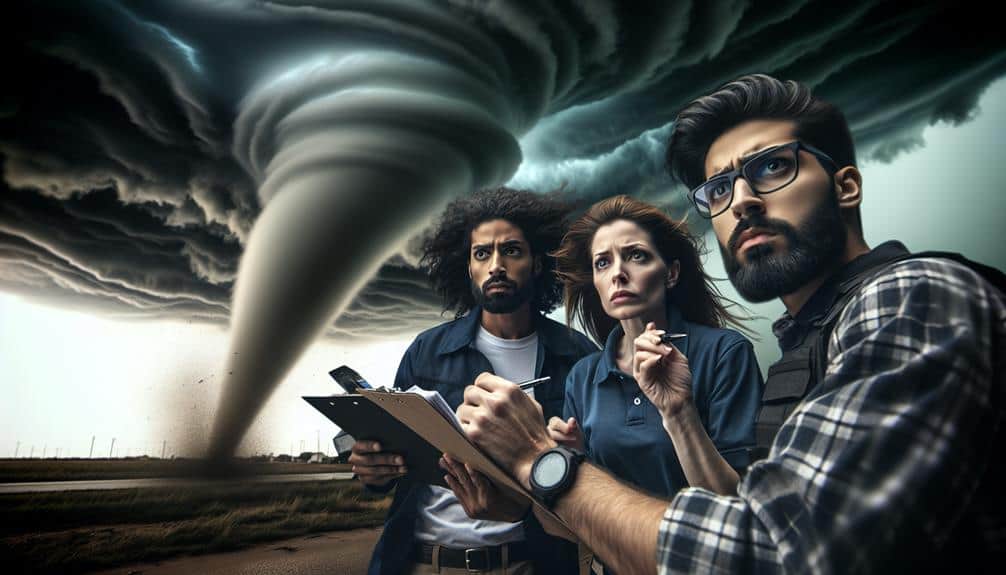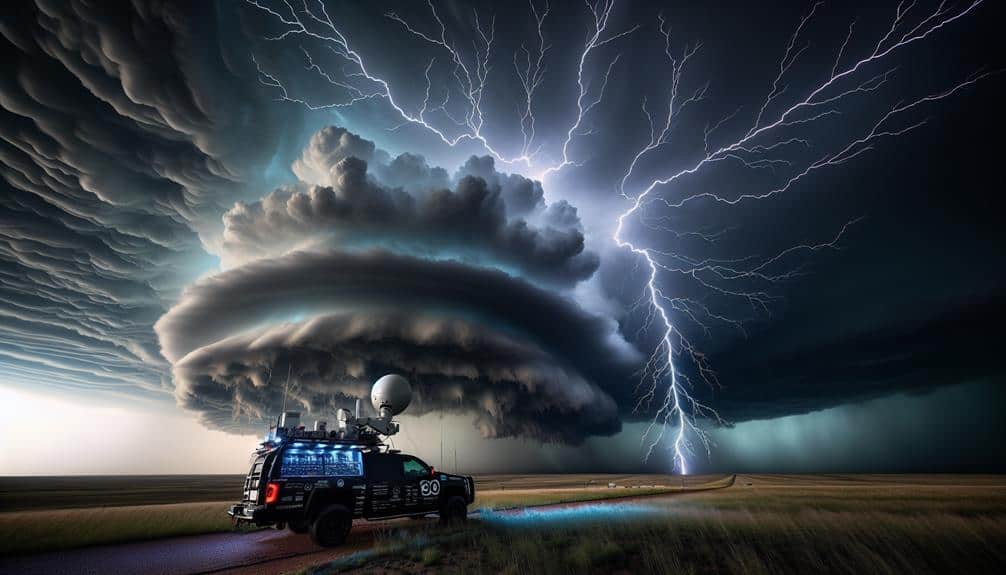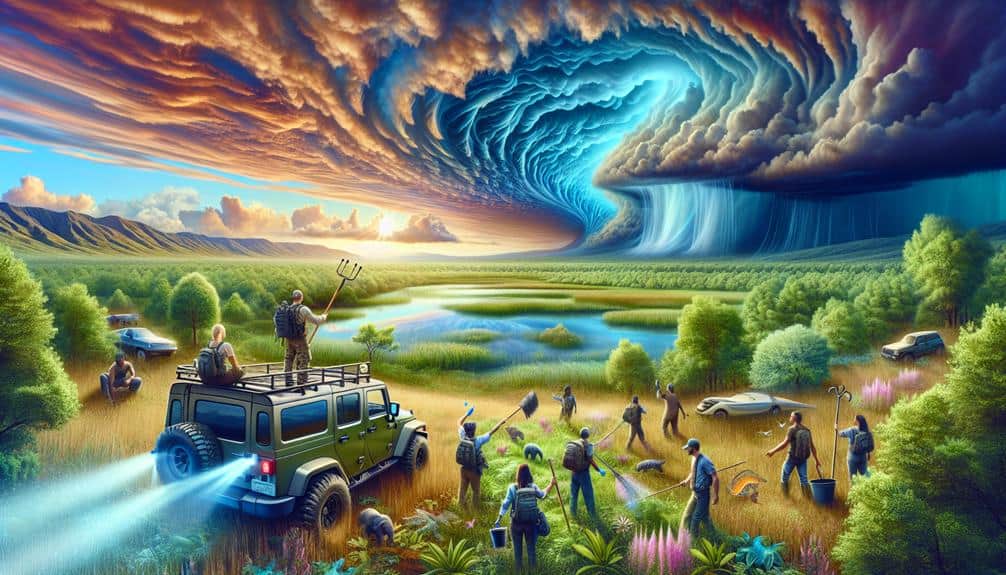By responsibly engaging in storm chasing, we can make a significant impact on climate change awareness. Prioritizing safety while using advanced technology like radar and GPS helps us gather accurate data and educate the public in real-time. We can minimize our environmental footprint by choosing eco-friendly gear and sustainable travel practices. Collaborating with scientists and local communities allows us to turn each chase into an educational experience through workshops and live updates. Using social media and community outreach, we inform and empower people to take action. Discover how these practices enhance our efforts and build community resilience.
Key Points
- Share real-time data and live updates to educate the public and raise awareness about climate change impacts.
- Utilize advanced technology like radar, GPS, and mobile apps for engaging and interactive public learning.
- Organize workshops and live demonstrations emphasizing storm safety and climate change realities.
- Partner with local organizations, schools, and influencers to reach broader audiences and foster community engagement.
Importance of Responsible Chasing
Responsible storm chasing plays a vital role in guaranteeing both the safety of the chasers and the integrity of the data collected. When we head out to track storms, our primary goal is to gather essential information that can aid in climate advocacy. By adhering to responsible practices, we guarantee that the data we collect is accurate and can be used to highlight the environmental impact of severe weather events. This, in turn, helps us make a compelling case for stronger environmental protection measures.
We know that the thrill of storm chasing can be intoxicating, but we've got to remember the bigger picture. Our actions not only impact our safety but also the environment. By staying within ethical boundaries and avoiding unnecessary risks, we help minimize any negative environmental impact. This means not disturbing local wildlife, avoiding damage to property, and making sure that our presence doesn't exacerbate the storm's effects.
Balancing Safety and Awareness
As we balance safety and awareness in storm chasing, we must prioritize our team's safety while leveraging real-time data to educate the public.
By implementing strong safety protocols, we can minimize risks and still gather valuable information.
Engaging with communities through live updates and outreach secures our findings help raise climate change awareness effectively.
Prioritizing Storm Chaser Safety
Balancing the thrill of storm chasing with the necessity of safety is crucial for those of us dedicated to raising climate change awareness. We've all felt the adrenaline rush of being close to nature's most powerful forces, but we must remember: safety first, always.
Before we even think about hitting the road, we conduct a thorough risk assessment. This means not just knowing the storm's path, but also understanding the terrain, our vehicle's capabilities, and each team member's experience level.
We equip ourselves with essential safety gear, including first aid kits, communication devices, and emergency supplies. Our vehicles are checked and rechecked to guarantee they're in top condition. We also have a solid plan for quick evacuation if things take a dangerous turn.
Moreover, we practice situational awareness at all times. This involves constantly monitoring weather updates, staying in contact with local authorities, and being prepared to change our plans on the fly.
While the goal is to capture compelling footage to educate the public about climate change, we can't do that if we're not safe ourselves. Balancing excitement and caution allows us to continue our mission effectively and responsibly.
Educating Through Real-Time Data
In the heat of the pursuit, we employ real-time data to both stay safe and maximize our educational impact on climate change awareness. By integrating cutting-edge technology, we not only enhance our safety but also transform storm chasing into an interactive learning experience. Using advanced radar, GPS, and mobile apps, we gather and share data in real-time, making climate education accessible and engaging.
We believe that empowering citizen scientists through real-time data fosters a deeper understanding of climate change. When we share live updates, videos, and data visualizations, our audience gains firsthand insights into the dynamics of severe weather. This approach makes complex scientific concepts more relatable and easier to grasp.
Furthermore, our dedication to technology integration guarantees that the information we provide is timely and accurate. By combining our field expertise with interactive learning tools, we offer a unique educational platform that captivates and informs.
In this manner, we balance the excitement of storm chasing with our mission to raise climate change awareness. It's not just about the pursuit; it's about turning each storm into a powerful lesson on the urgency of addressing climate issues.
Community Engagement Strategies
We often prioritize community engagement by organizing workshops and live demonstrations that emphasize both safety protocols and the realities of climate change. By partnering with local organizations, schools, and community centers, we create outreach events that provide practical information on storm preparedness while highlighting the increasing frequency of severe weather due to climate change. These local partnerships are key to building trust and ensuring our message reaches a diverse audience.
To expand our reach, we leverage social media platforms and influencer collaborations. By sharing real-time updates, educational content, and engaging visuals, we capture the attention of a wider audience who mightn't attend physical events. Influencers who are passionate about climate action help amplify our message, making it resonate with their followers. This dual approach—combining in-person and online strategies—ensures we maintain a balance between promoting safety and raising climate change awareness.
Ultimately, our goal is to empower communities to take informed action. By providing accurate information and demonstrating practical steps, we help individuals feel more prepared and motivated to advocate for broader environmental initiatives. Together, we can make a significant impact on climate change awareness and community resilience.
Ethical Footage and Reporting
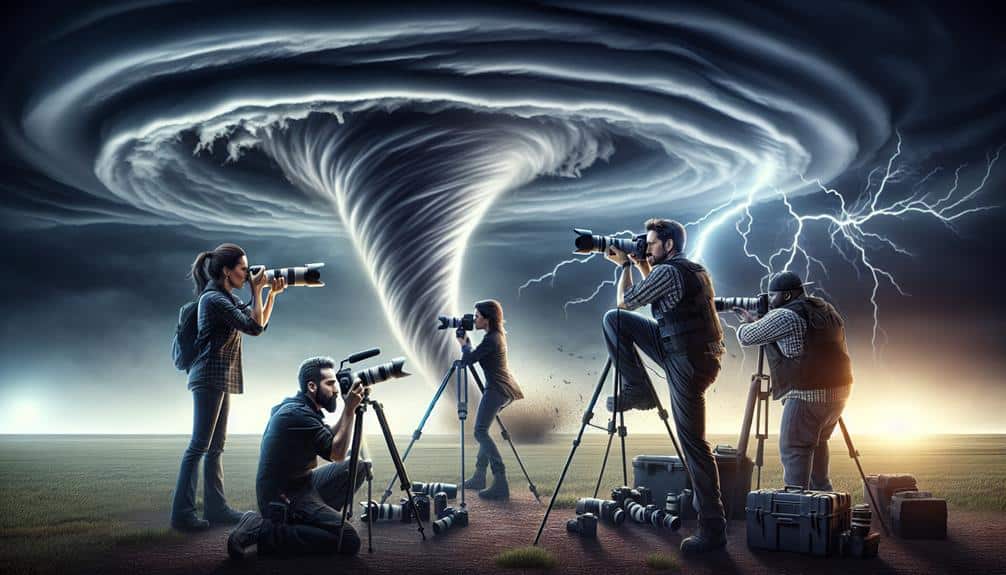
Capturing and reporting storm footage ethically is vital for maintaining public trust and effectively raising climate change awareness. We must practice ethical journalism and responsible documentation to make certain that our audience receives accurate and impactful information. By doing so, we can highlight the realities of extreme weather events without sensationalism or exaggeration.
When we're out in the field, it's crucial to respect the communities affected by these storms. This means obtaining consent before filming individuals and avoiding the exploitation of their vulnerability. Responsible documentation ensures that we're not just chasing the most dramatic footage but also telling the whole story, including the aftermath and the resilience of these communities.
Additionally, we should prioritize safety, both for ourselves and those around us. Reckless behavior not only puts lives at risk but also undermines the integrity of our work. By adhering to these principles, we can create powerful content that informs and educates the public about the urgent issue of climate change.
In a world where misinformation spreads rapidly, our commitment to ethical journalism and responsible documentation is more significant than ever. Let's use our platform to bring about meaningful change and inspire action on climate change.
Collaborating With Scientists
Partnering with scientists allows us to enhance our storm chasing efforts by grounding our footage in robust scientific data. When we team up with researchers, our visuals aren't just engrossing—they're informative.
Through research partnerships, we're able to collect data that offers deeper insights into storm patterns and their broader climate impact. This collaboration helps us bridge the gap between raw footage and scientific understanding, making our work not just a spectacle but a valuable tool for climate awareness.
Our scientific collaboration offers a dual benefit: we get access to cutting-edge technology and methodologies, while scientists gain on-the-ground data that's often difficult to obtain. This exchange bolsters our ability to provide accurate, real-time information, enhancing the credibility of our reporting. When viewers see how our footage aligns with empirical data, it strengthens the message about the urgency of climate change.
Moreover, these partnerships allow us to stay updated on the latest findings, ensuring our content remains relevant and impactful. By working closely with scientists, we're not just chasing storms; we're contributing to a broader understanding of their role in our changing climate.
Together, we can inspire action and awareness through informed storytelling.
Reducing Environmental Impact
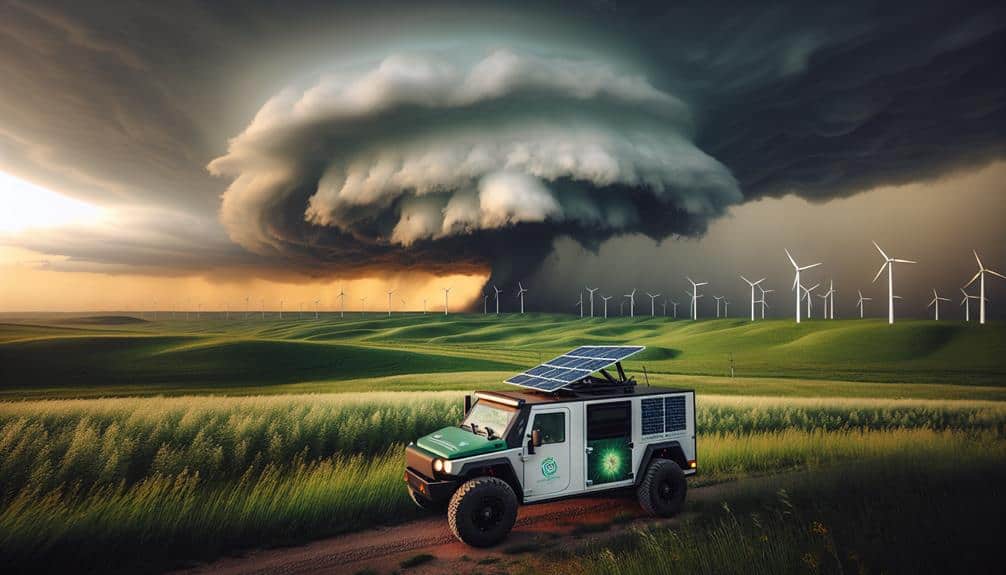
As storm chasers, we can reduce our environmental impact by choosing eco-friendly equipment and adopting sustainable travel practices.
By minimizing our carbon footprint, we'll not only protect the planet but also set a positive example for others.
Let's explore how these changes make a difference in our mission.
Eco-friendly Equipment Choices
Choosing eco-conscious equipment for storm chasing can significantly reduce our environmental footprint while raising awareness about climate change. By selecting energy-efficient gear, we not only minimize our carbon emissions but also set an example for eco-conscious practices within the storm-chasing community. Let's explore some sustainable options that can make our adventures more planet-friendly.
Firstly, consider using energy-saving gear. Devices such as solar-powered chargers and LED lights can keep us powered up without depending on fossil fuels. These choices aren't only practical but also reduce the impact on our environment.
Furthermore, opting for equipment made from recyclable materials ensures that when it's time to upgrade, we're not contributing to the increasing issue of electronic waste.
Integrating eco-friendly practices doesn't end at gear selection. We can opt for sustainable choices for everything from our clothing to our data collection tools. Choosing biodegradable or recyclable materials in our field kits can have a significant impact.
By making these thoughtful choices, we're not just storm chasers—we're advocates for a healthier planet.
Together, let's embrace these eco-conscious equipment choices to improve our storm-chasing experiences and contribute to a more sustainable future.
Sustainable Travel Practices
Embracing sustainable travel practices can greatly reduce our environmental impact while we're out chasing storms. By choosing green transportation options like electric vehicles or carpooling, we can cut down on emissions. Public transport, biking, or even walking where possible are also great choices that let's explore with minimal environmental footprint.
When it comes to where we stay, opting for eco friendly accommodations is a smart move. Many hotels and lodges now offer sustainable options, from solar-powered energy to water-saving fixtures. These choices not only support environmentally responsible businesses but also inspire others to follow suit.
Sustainable packing is another crucial aspect. Let's minimize waste by bringing reusable items like water bottles, utensils, and shopping bags. Packing light reduces fuel consumption, too, especially on flights or long drives.
Lastly, let's talk about ethical dining. Sourcing local, organic food supports local economies and reduces the carbon footprint associated with food transport. Eating plant-based meals when possible can also make a significant difference.
Minimizing Carbon Footprint
Reducing our carbon footprint is crucial if we want to make a positive impact on climate change while storm chasing. We need to adopt sustainable practices that not only allow us to pursue our passion but also protect the environment we cherish.
One of the first steps is to minimize our use of fossil fuels. Carpooling with fellow storm chasers or opting for fuel-efficient vehicles can markedly reduce emissions.
Incorporating green technology into our storm chasing toolkit is another essential approach. By using solar-powered devices for our equipment and communication needs, we cut down on the reliance on non-renewable energy sources. Additionally, we can invest in electric or hybrid vehicles, which emit fewer pollutants compared to traditional gas-powered cars.
We should also consider our overall travel footprint. Planning our routes efficiently and combining trips can save both time and fuel. Let's make it a point to support eco-friendly accommodations and local businesses that prioritize sustainability.
Educating the Public
Storm chasers can captivate audiences and foster a deeper understanding of climate change by sharing their firsthand experiences and observations. By embracing public outreach and educational initiatives, we can bridge the gap between abstract scientific concepts and real-world impacts.
Here's how we can make a difference:
1. Public outreach and educational initiatives:
We should engage with schools, community centers, and online platforms to share our knowledge. Interactive workshops, school presentations, and Q&A sessions can ignite curiosity and drive home the reality of climate change.
2. Media partnerships and outreach events:
Forming collaborations with local and national media outlets can amplify our message. By participating in documentaries, news segments, and social media campaigns, we can reach a broader audience. Outreach events such as public talks and storm-chasing tours offer immersive experiences that leave lasting impressions.
3. Leveraging technology:
Utilizing live streaming and virtual reality can bring people closer to the action without leaving their homes. These technologies can create vivid, engaging experiences that highlight the urgency of addressing climate change.
Frequently Asked Questions
How Can Storm Chasers Leverage Social Media to Raise Climate Change Awareness?
We can leverage social media by creating online campaigns that boost engagement. Partnering with influencers will amplify our impact, helping us reach wider audiences and raise awareness about climate change through compelling storm-chasing content.
What Technology Is Essential for Effective Storm Chasing and Data Collection?
When we chase storms, remote sensing is our eyes in the sky, and meteorological drones are our wings. These technologies let us collect precise data, helping us understand weather patterns and share essential information with the world.
Do Storm Chasers Work With Local Communities During Their Expeditions?
Yes, we engage with local communities during our storm chasing. Our efforts focus on community engagement and emergency response, ensuring that residents are informed and prepared. This collaborative approach helps build trust and enhances overall safety.
How Do Storm Chasers Stay Updated on the Latest Climate Science?
We keep our fingers on the pulse of climate research through partnerships with leading scientists. By integrating cutting-edge data and maintaining open communication, we stay updated and ready to adapt to the latest advancements in climate science.
What Are the Financial Costs Involved in a Typical Storm Chasing Expedition?
When we consider the financial costs of storm chasing, the cost breakdown includes travel, equipment, and insurance. Funding sources often include personal savings, sponsorships, and grants. It's a thrilling, yet costly, passion.
